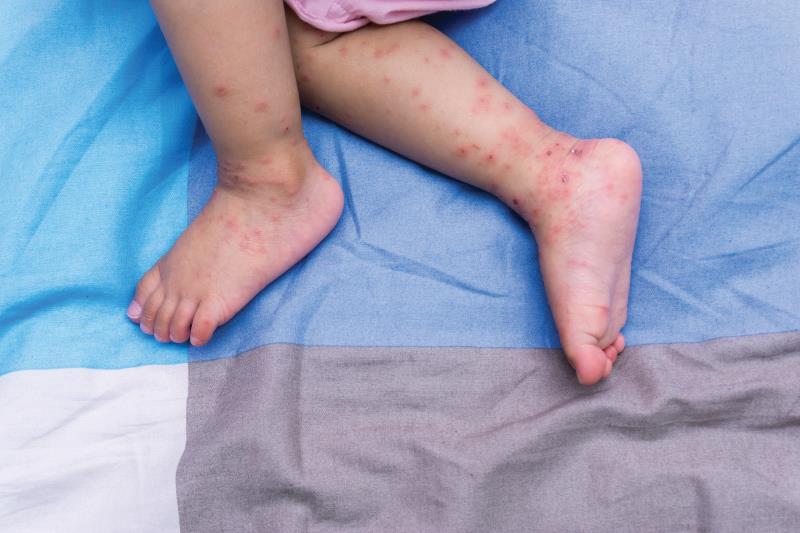
While generally a self-limiting condition, hand, foot, and mouth disease (HFMD) can spread very quickly, particularly among children attending childcare centres. Dr Chan Si Min, Head and Senior Consultant at the Division of Paediatric Infectious Diseases, National University Hospital, Singapore, talks to Roshini Claire Anthony about the complications and management of HFMD.
Introduction
HFMD is a common childhood viral disease caused by enteroviruses that belong to the human enterovirus A species of the family Picornaviridae, most commonly Coxsackie virus type A (CA) and Enterovirus 71 (EV71). Enteroviruses are small non-enveloped positive stranded RNA viruses that are composed of four structural proteins called VP1, VP2, VP3, and VP4. VP1 is the major capsid protein, and molecular typing of the gene encoding it is used to classify circulating strains.
Enteroviruses are neurotropic viruses. EV71 directly infects central nervous tissue and is associated with histologic findings of severe inflammation in the hypothalamus, brainstem, spinal cord, and cerebellar dentate nucleus. Pathogenesis of virologic and host factors affecting disease severity are not well understood.
Among the Coxsackie viruses, CA10, CA6, and CA16 are the predominant serotypes seen in Singapore.
Large outbreaks of HFMD have been reported in Asia-Pacific countries including Malaysia, Taiwan, Japan, Korea, Australia, Brunei, Vietnam, Cambodia, and mainland China. HFMD is endemic in Singapore, with more than half of the cases occurring in children below age 5 years. According to a Ministry of Health report in 2018, the incidence rate of HFMD was >14,000 per 100,000 children aged 0–4 years.
Disease transmission
HFMD is transmitted through direct contact with nasal discharge, saliva, respiratory secretions, vesicular fluid, or faeces from an infected person, or indirect contact with contaminated items. Viral shedding can continue from the upper respiratory tract for 2 weeks and from the gut for 4–12 weeks.
HFMD transmission can occur rapidly in childcare centres and kindergartens, with attack rates usually <10 percent but up to >40 percent in some preschools. Clusters or outbreaks occur regularly and may sometimes result in school closure in order to halt transmission. Early diagnosis and appropriate infection control measures help to reduce transmission at home and in school. The clinical burden of HFMD also has a significant public health impact due to school and work absence among parents who require time off work for childcare.
Diagnosing HFMD
Typically, symptomatic infections manifest as brief fever, with rashes on the hands and feet (HFMD), and/or mouth ulcers (herpangina). Symptoms usually resolve in 7–10 days. HFMD/herpangina caused by EV71 can progress rapidly to neurological involvement (aseptic meningitis, encephalitis, encephalomyelitis, acute flaccid paralysis) and autonomic dysfunction leading to neurogenic pulmonary oedema, pulmonary haemorrhage, and cardiopulmonary failure. Symptoms include blood pressure instability (hypertension or hypotension), cold sweats, hyperglycaemia, and frequent myoclonic jerks.
Poor oral intake in an otherwise well child may be a sign of pharyngeal ulcers. GPs should have a high index of suspicion for HFMD if a child presents with non-specific febrile illness and there is recent history of contact with other children who have HFMD such as in a preschool cluster.
HFMD and herpangina are primarily clinical diagnoses based on the typical features described. A nasopharyngeal or throat swab can be tested for enterovirus PCR to confirm diagnosis. Enterovirus PCR can also be tested in cerebrospinal fluid samples for those with suspected neurological infection, or in stool/rectal swabs.
Although HFMD is usually a benign self-limiting illness, it can sometimes cause severe illness such as dehydration requiring hospital admission, and rarely, neurological or cardiopulmonary complications, or mortality. Children with HFMD caused by the EV71 virus can present with subtle clinical features early in the illness course and deteriorate rapidly with a fulminant disease course. Most survivors of EV71 cardiopulmonary failure have moderate to severe neurological sequelae.
Children with signs of dehydration or neurological involvement (eg, irritable, excessive crying, lethargy, seizures) should be evaluated in hospital as soon as possible. Early recognition and timely supportive intervention are needed to reduce morbidity and mortality.
Diagnostic challenges
Mild infections may be asymptomatic, or manifest as mild febrile illness or non-specific viral symptoms such as upper respiratory tract infection or loose stools. Typical features of HFMD and herpangina may also not be seen in severe EV71 infections. A positive PCR result in an asymptomatic child may reflect gut carriage or post-infectious shedding.
Young children are difficult to examine, and ulcers at the back of throat may not be easily visualized. Children may also see the GP early in the illness course when there is only fever or poor feeding, and ulcers or rash may not be apparent yet. Knowledge of specific exposure such as at home or in a childcare centre (cluster/outbreak) may help to make a presumptive diagnosis.
Managing HFMD
There are two aspects to HFMD management – symptomatic management and infection control. Symptomatic management involves managing fever with antipyretics and improving hydration by encouraging oral fluid intake. Children with painful oropharyngeal ulcers often prefer soft food, cold drinks, or sucking on ice lollies made of frozen rehydration solution. Infection control measures and droplet precautions (eg, frequent hand washing, no sharing of utensils/towels, no kissing, cleaning of toys and surfaces, and appropriate cough etiquette including use of surgical masks in an older child) can prevent transmission of HFMD to close contacts at home and in school.
Conclusion
It is important for GPs to ask about specific exposure to HFMD at home or in school/childcare centres, and to have a high level of suspicion if the child presents early in illness when clinical signs and symptoms are still evolving. Parents should be advised on what symptoms to look out for, and when to return to see the doctor. GPs should be vigilant for children with poor oral intake leading to dehydration, irritability, or other neurological involvement as these children should be evaluated in hospital.
 Dr Chan Si Min
Dr Chan Si Min